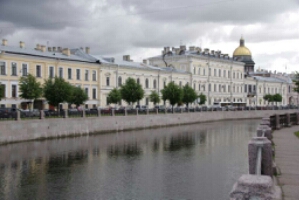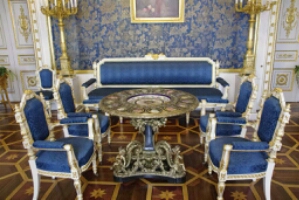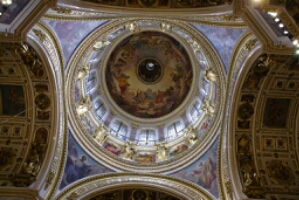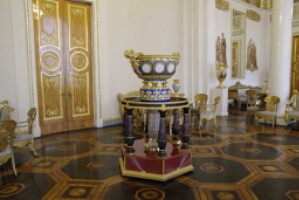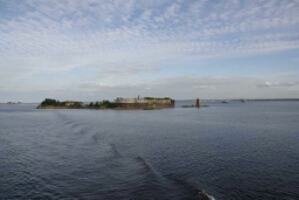It looked a bit more cloudy this morning, so we took our umbrellas with us on our last day in St. Petersburg. However, it did not rain on us although the street was wet as we exited from the first museum.
It did not take us long to get to Yasupov Palace, where we first went down into the basement to see a display about Rasputin, as this is where he was killed. Following this we walked around the rest of the palace, including a brief stop in the concert hall where we heard a Russian men’s chorus sing a selection for us. The Yasupov’s were as wealthy as the Romanovs, and the furnishing and interiors of the palace were equisite. It was very interesting that they tried to hide their possesions in secret rooms within the palace, after the Russian Revolution; however their treasures were all discovered within about two years.
St. Isaac’s Cathedral, topped by a golden dome that is over 90 metres high, was our next morning stop. The interior of the church is huge, and beautiful. Not perhaps as opulent as the Church on the Spilled Blood, but it so big that it’s interior seemed very uncrowded, even with the crowds of tourists. At the top of the dome on the interior is a symbolic white dove. From the floor it doen’t look very large, yet 90 meters above you the actual size is over 5 metres wide.
From the cathedral we walked on the streets of Moscow to a small restauraunt Gogol named after the Russian author. Here we had a nice Russian meal again, this one the most expensive, but it was in a nice small room where we were the only clients.
After lunch we walked along the Nevsky Prospekt, the largest street in St. Petersburg. We went into a couple of stores, one of which sold high end foods and candies.. Our guide indicated that even in the Soviet era it was the store where you could buy the most expensive foods. We also went into a fur coat store. They had some beautiful mink coats there. We talked to our guide about how politically incorrect it would be in Canada to wear real fur. She had difficulty understanding why. We did have a good time sharing with her some of the differences in culture in Russia and Canada.
We stopped in at Kazan Cathedral, a functioning Russian Orthodox church. Restored after the fall of the Soviet Empire, it has a beautiful silver iconostastis. There was a long line of worshippers waiting to kiss the Icon of our Lady of Kazan. Our guide was most interested in this church because she is a Tartar.
After this we went to the State Russian Museum. It contains much less art than the Hermitage, but also many, many times smaller crowds trying to see things. I most enjoyed the art from the late 19th and 20th centuries. “Barge Haulers on the Volga” by Repin was one of my favorites. It reminded me of pictures I’ve seen of hauling York boats up the North Saskatchewan River. I would have liked to have seen a better exhibition of art from the Soviet period. Our guide rather rushed through this part of the exhibit, and I would far prefer to have seen it than the old 15th century paintings.
We drove back through a big traffic jam in central St. Petersburg. At the parking lot near the museum there half a dozen tow trucks loading up cars that were illegally parked. One of the big problems was double parked cars which blocked one complete lane of traffic, and which our guide said was illegal. Our driver cut in and out beside buses, vans and other cars to find a way through. He made good use of the GPS on his phone which constantly showed the updating traffic jams.
We were back on board ship by 4:30. As we were eating supper our ship pulled away from the dock, and we are now sailing down the Gulf of Finland towards Tallinn, Estonia where we will be tomorrow. In the Gulf there are the remains of old fortresses which once guarded the port of St. Petersburg.

